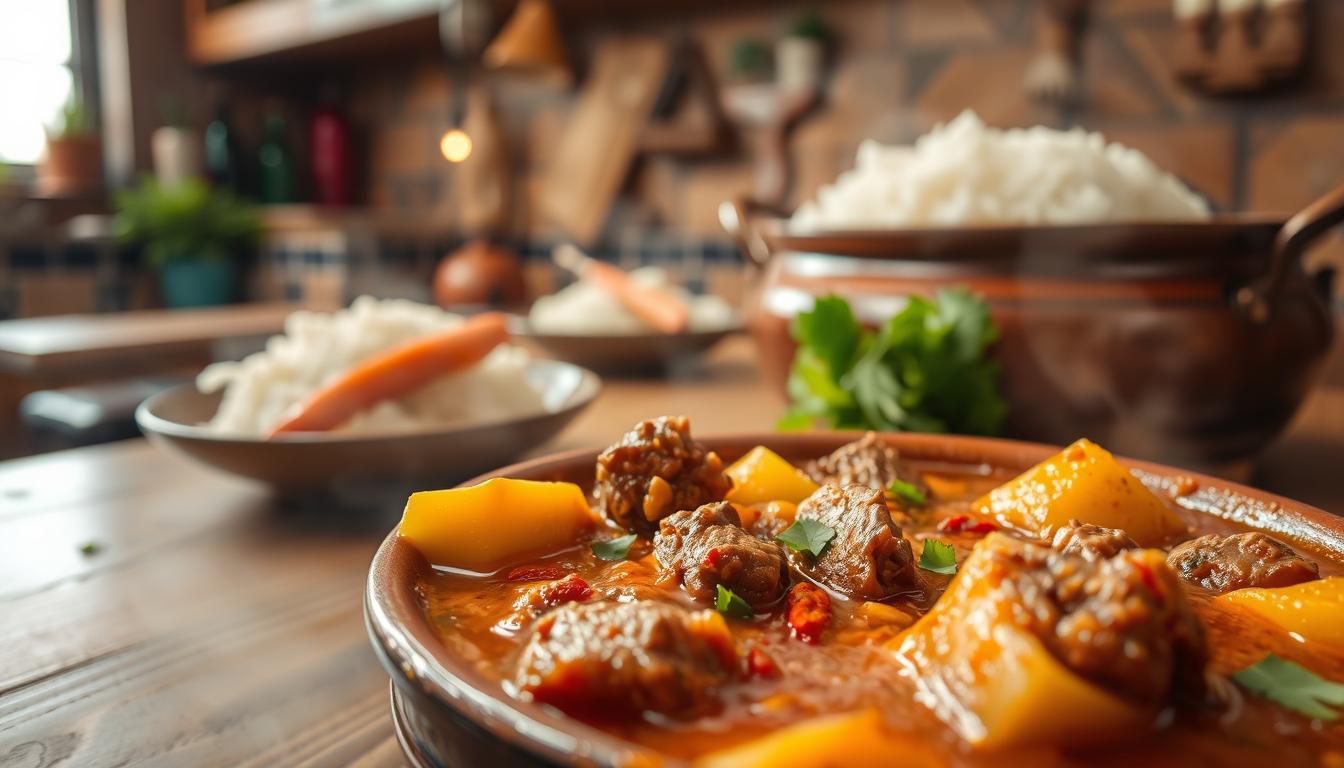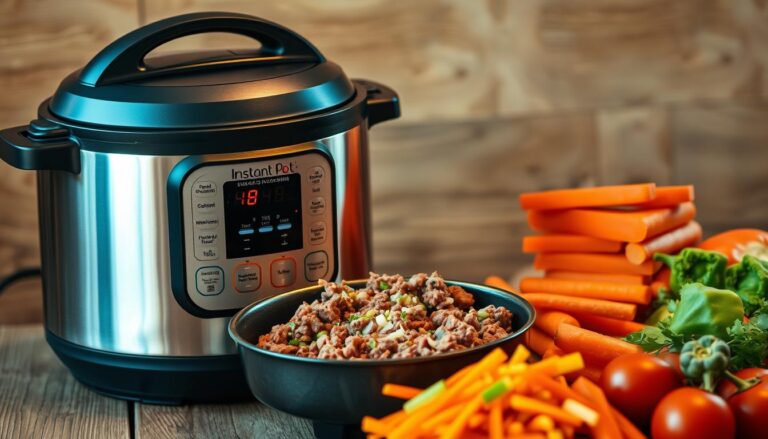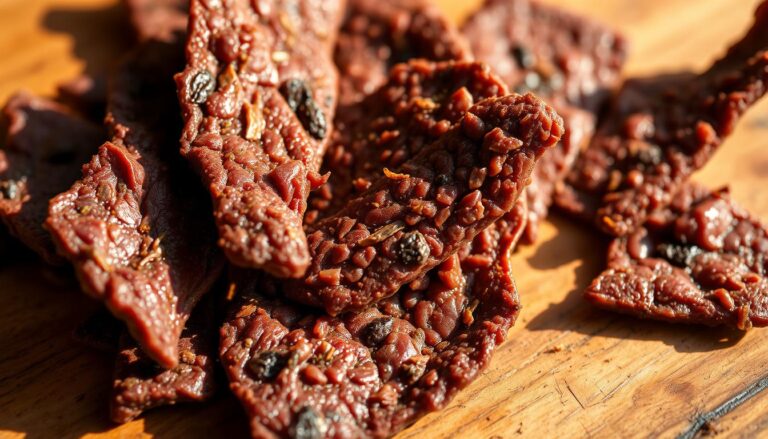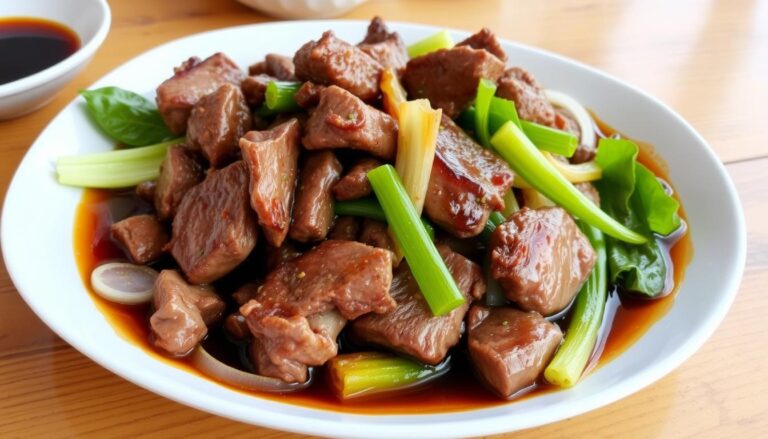Easy Beef Caldereta Recipe: Authentic Filipino Taste
Growing up in a Filipino-American home, I loved family gatherings. My grandmother’s beef caldereta was always the highlight. The smell of slow-cooked meat and spices filled the kitchen, creating unforgettable memories.
A beef caldereta recipe is more than food—it’s a journey through Filipino culture. This hearty stew showcases the vibrant flavors and traditions of the Philippines. Whether you’re new to Filipino cuisine or making a family favorite, this recipe will take you to the Philippines.
Every bite of this dish tells a story of comfort and tradition. The tender beef, rich sauce, and spices make it a true celebration of Filipino cooking. Get ready to add this authentic recipe to your cooking collection.
Table of Contents
Understanding Filipino Beef Caldereta
Explore the rich world of Filipino cuisine, where every caldereta recipe shares a story. It’s a dish that captures the heart of Filipino cooking. It’s more than just a meal; it’s a tradition.
The roots of this dish go back to the Spanish colonial period. Caldereta comes from the Spanish word caldera, meaning cauldron. This name fits its traditional cooking method perfectly.
Origins and Cultural Significance
Filipino cuisine is a mix of many influences. The caldereta recipe is a great example. Introduced during the Spanish colonial era, it blends European cooking with local ingredients.
- Brought by Spanish colonizers in the 16th century
- Adapted using local meat and spices
- Became a staple in Filipino households
Regional Variations Across Philippines
Different regions have their own twist on the kaldereta recipe. From coastal to mountain areas, each place adds its own special touch.
- Luzon: Uses goat meat and richer sauces
- Visayas: Incorporates more local vegetables
- Mindanao: Adds spicier elements to the recipe
What Makes Caldereta Different from Other Filipino Stews
The caldereta recipe is unique because of its flavors. It has a rich tomato-based sauce, tender meat, and a special spice mix. These make it different from other Filipino dishes.
A true caldereta is not just a meal, but a celebration of Filipino culinary heritage.
Whether you love cooking or just enjoy food, trying the kaldereta recipe is a tasty way to explore Filipino culture and tradition.
Essential Ingredients for Authentic Beef Caldereta Recipe
Making a tasty beef caldereta begins with picking the right ingredients. Your journey into this classic Filipino dish needs careful ingredient choice. This brings out the rich, deep flavors that make traditional caldereta special.
Choosing the right meat is key when preparing beef for caldereta. The quality and cut of beef greatly affect the dish’s taste and texture.
Selecting the Perfect Beef Cuts
To make an authentic caldereta, pick beef cuts that get tender with slow cooking. Good cuts include:
- Beef chuck
- Beef brisket
- Beef short ribs
Key Seasonings and Spices
The ingredients that give caldereta its unique flavor are:
- Liver spread for rich depth
- Garlic and onions
- Tomato sauce
- Soy sauce
- Black pepper
Traditional Vegetables
Classic caldereta vegetables add texture and nutrition. Typical vegetables include:
- Potatoes
- Carrots
- Bell peppers
- Green peas
Pro tip: Fresh, high-quality ingredients are the secret to an authentic beef caldereta that will impress your family and friends.
Preparation Tips and Techniques
Preparing beef caldereta needs careful attention. Start by choosing the right ingredients and using the right techniques. The first steps are crucial for a delicious Filipino stew.
Here are key techniques for preparing beef:
- Choose a tough cut of beef like chuck or brisket for maximum flavor
- Cut meat into uniform 1-inch cubes for even cooking
- Pat beef dry with paper towels to ensure proper searing
Blanching is a key step. It removes impurities and tenderizes the meat. Briefly boil the beef chunks in water for 2-3 minutes, then cool them in an ice bath.
Searing the meat adds a rich flavor. Heat oil in a heavy pot until it smokes. Add beef cubes in batches, letting each piece get a golden-brown crust. This keeps the meat’s juices in and adds depth to your caldereta.
- Use high heat when searing
- Don’t overcrowd the pan
- Allow meat to develop a golden-brown crust
Pro tip: Let the meat rest for a few minutes after searing to retain its juiciness and flavor.
Mastering these techniques will make your beef caldereta amazing. Each step adds flavor, making this traditional Filipino dish special.
Step-by-Step Cooking Instructions
Cooking tomato beef caldereta needs patience and care. It turns simple ingredients into a rich, hearty dish that will excite your taste buds.

Start by picking the right ingredients and learning key cooking skills. We’ll guide you through easy steps to make a tasty caldereta.
Preparing the Beef
Choose a tender beef cut like chuck or round. Cut it into 1-inch cubes. Season the beef with:
- Salt
- Black pepper
- Garlic powder
Creating the Sauce Base
The sauce is the heart of tomato beef caldereta. Start by sautéing minced garlic and onions in a big pot. Brown the seasoned beef cubes until they’re rich and caramelized.
Adding Vegetables and Final Seasoning
Add beef caldereta ingredients like:
- Diced potatoes
- Carrots
- Bell peppers
- Tomato sauce
Let the stew simmer until the beef is tender and the veggies are cooked just right. Add patis (fish sauce) and black pepper to boost the flavor.
The Secret to Rich and Flavorful Sauce
Making a great beef caldereta sauce is more than just using the right ingredients. It’s about adding special touches that make the dish stand out. These unique elements turn a simple stew into a true masterpiece.
Top Filipino chefs share two secrets for a richer sauce:
- Liver spread: It brings a deep umami flavor
- Creamy peanut butter: Adds smoothness and depth
The sauce’s flavor grows with careful cooking. Slow cooking lets the ingredients blend perfectly. This way, the sauce becomes a symphony of tastes.
“The perfect caldereta sauce is about patience and understanding how ingredients interact.” – Filipino Culinary Experts
Keeping the heat low is key. It helps the sauce thicken and intensify flavors. Stir it now and then to avoid burning and ensure even flavor.
Some people add cheese or cream to their sauce. These can make it even richer. Try these to find your favorite flavor.
Traditional Cooking Methods vs Modern Adaptations
Cooking slow-cooked beef caldereta has changed over time. Your choice of cooking method affects the dish’s taste, texture, and how long it takes to prepare.
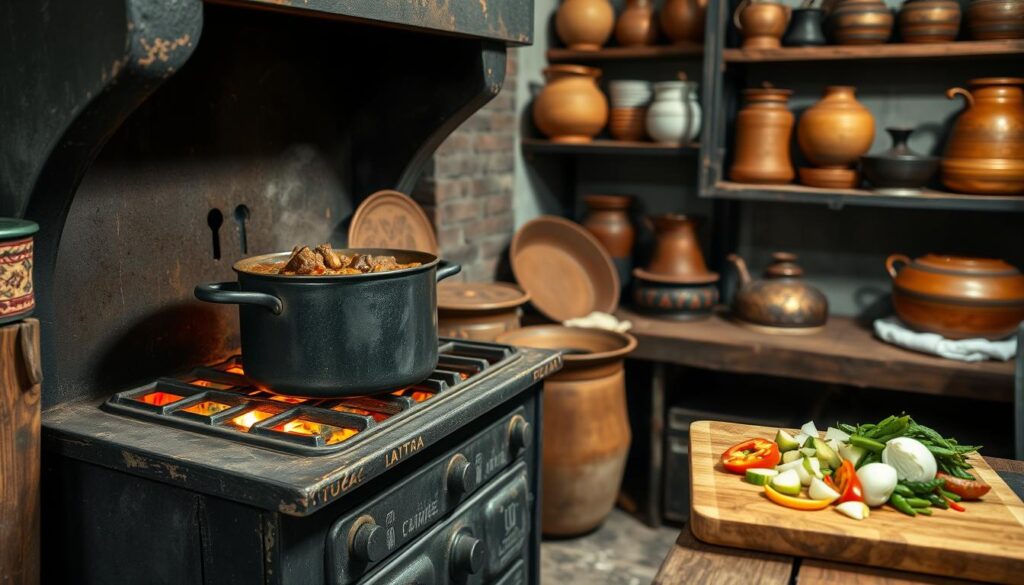
Filipino home cooks love making slow-cooked beef caldereta. They use old methods that need patience and time. This lets flavors grow and meat get tender.
Classic Slow-Cooking Approach
The traditional way to cook beef caldereta involves:
- Using a heavy-bottomed pot or clay casserole
- Cooking on low heat for 2-3 hours
- Allowing meat to tenderize gradually
- Developing deep, rich flavors
Pressure Cooker Innovations
Modern kitchens use pressure cookers to save time. This method has many benefits:
- Reduced cooking time from hours to 45-60 minutes
- Consistent meat tenderness
- Retention of nutrients and flavors
- Convenient for busy home cooks
Even with different techniques, the goal of a tasty slow-cooked beef caldereta stays the same. Whether you go traditional or modern, keeping true to Filipino flavors is key.
Customizing Your Beef Caldereta Recipe
Your beef caldereta recipe is a blank canvas for creativity. Traditional recipes are a good start, but adding your own twist can make it special. It becomes a dish that’s truly yours.
When making beef caldereta with potatoes, you can try many things:
- Adjust the spice level by adding more or less chili peppers
- Incorporate different vegetables like caldereta with carrots for added nutrition
- Experiment with cheese varieties to create a unique sauce texture
- Try substituting traditional ingredients with regional alternatives
Cheese can really change how your caldereta tastes. Queso de bola or cheddar can make the sauce creamy and rich. Coconut milk is a good choice for a lighter version, adding a tropical flavor.
There are many ways to make your caldereta unique. Some like it spicier with more liver spread. Others prefer it milder with fewer chili peppers. The goal is to find the right balance of flavors.
Remember, cooking is an art of personal expression. Don’t be afraid to make your beef caldereta uniquely yours!
Pro tip: When adding beef caldereta with potatoes, cut them into uniform sizes to ensure even cooking. For caldereta with carrots, choose younger, tender carrots that will absorb the rich sauce beautifully.
Serving Suggestions and Pairings
Your authentic caldereta recipe deserves a perfect presentation. It’s more than just a meal—it’s a journey that brings people together.
Serving an authentic caldereta recipe needs attention to detail. The right accompaniments can make your meal extraordinary.
Perfect Side Dishes
Here are some traditional sides for your beef caldereta:
- Steamed white rice
- Garlic fried rice (sinangag)
- Crusty bread for soaking up rich sauce
- Pickled vegetables
Optimal Serving Temperature
Temperature is key for enjoying your caldereta. Serve it hot, around 165°F (74°C), for the best flavor and texture.
Beverage Pairings
Here are some drinks that go well with your caldereta:
- San Miguel Beer
- Red wine with medium body
- Iced tea
- Coconut water
Remember, serving caldereta with love and sharing it with friends and family makes it unforgettable.
Storage and Reheating Guidelines
Keeping your beef caldereta recipe delicious means storing and reheating it right. After you’ve eaten, you’ll want the leftovers to taste as good as the first time.
Refrigeration is crucial for your beef caldereta’s quality. Here are some key storage tips:
- Store in an airtight container
- Refrigerate within 2 hours of cooking
- Keep in the fridge for up to 5 days
- Use clean, sealed containers to prevent contamination
Freezing is great for keeping your beef caldereta recipe fresh for longer. Here are some freezing tips:
- Cool the dish completely before freezing
- Use freezer-safe containers or heavy-duty freezer bags
- Remove excess air to prevent freezer burn
- Freeze for up to 2 months
When reheating, it’s important to keep the beef caldereta’s texture and flavor. Gentle reheating is crucial to prevent drying out the meat. Use these methods:
- Microwave with a damp paper towel covering the dish
- Stovetop reheating in a covered pan with a splash of water
- Oven heating at low temperature (around 350°F) for even warmth
Pro tip: Always ensure the beef caldereta reaches an internal temperature of 165°F to guarantee food safety when reheating.
Health Benefits and Nutritional Information
Beef caldereta is more than just a tasty Filipino dish. It’s full of nutrients that boost your health. It has a mix of protein-rich beef and veggies that are full of nutrients.
The beef in caldereta is a great source of protein. It has amino acids that help build and fix muscles. A serving has about 20-25 grams of protein, which is great for keeping muscles strong.
- Protein: Supports muscle growth and repair
- Iron: Helps prevent anemia and boosts energy levels
- Vitamins: Provides B-complex vitamins for metabolism
- Minerals: Contains zinc and selenium for immune support
To make your caldereta even healthier, choose lean beef and add more veggies. The veggies add important nutrients:
- Carrots: Rich in beta-carotene and vitamin A
- Bell peppers: High in vitamin C
- Potatoes: Provide complex carbohydrates and potassium
If you’re watching your calories, you can make the recipe healthier. Use leaner beef and add more veggies. A serving has 300-400 calories, depending on how it’s made and what’s in it.
Tip: Balance your meal by pairing caldereta with steamed rice and a fresh side salad to maximize nutritional intake.
Conclusion
Beef caldereta is more than a meal; it’s a journey into Filipino cuisine’s rich traditions. This hearty stew combines Spanish flavors with Philippine cooking. It’s a chance to explore new tastes.
Exploring beef caldereta shows its amazing versatility. Whether you’re cooking at home or trying new flavors, it’s perfect. You can tweak ingredients and cooking methods to make a dish that respects its roots.
Every time you make caldereta, you tell a new story. It’s about personal touches, family traditions, and local flavors. By mastering its techniques, you connect with a tradition that spans generations.
We encourage you to start your caldereta adventure in the kitchen. Share your stories, learn from each try, and enjoy the process. Mastering this Filipino classic is a rewarding journey.

